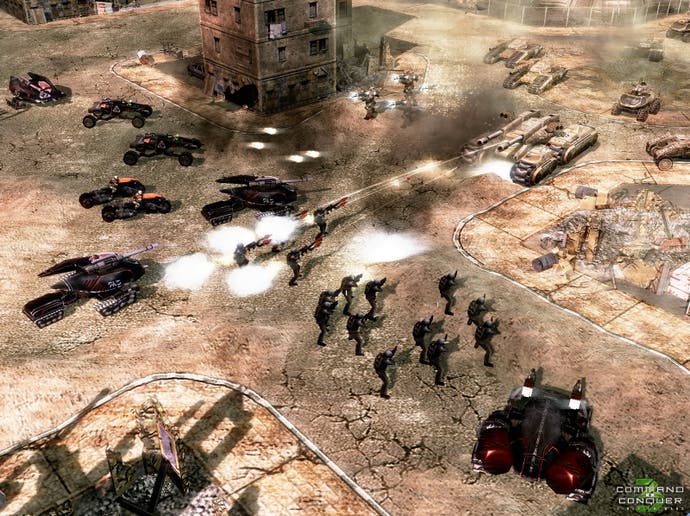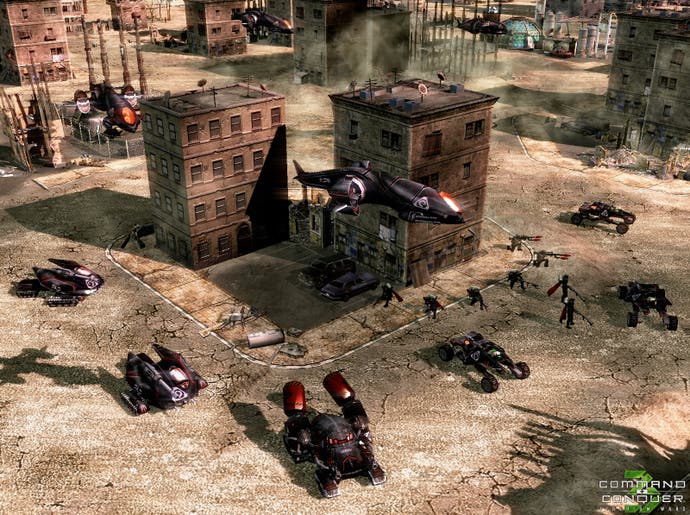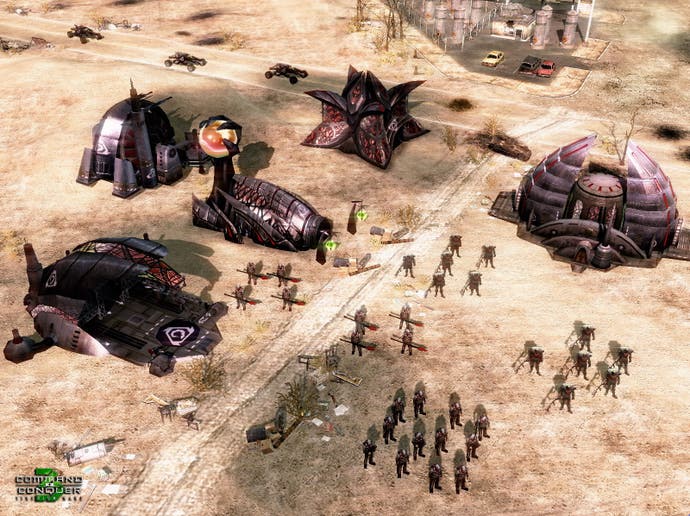Command & Conquer 3: Tiberium Wars
What it's like to play the latest C&C.
Seven years since the release of Command & Conquer: Tiberian Sun, the series that started it all is finally going to get the sequel that the fans have been waiting for. Tiberium Wars represents a return to the roots laid down in 1995 by the very first Command & Conquer. It marks a return to the Tiberian Series that predates both Red Alert and Generals, and is more fondly remembered than both. And that, really, is the main challenge that EA's Los Angeles studio has had to overcome (or conquer, if you like). How do you update such a seminal game, bringing it forward ten years into the future, without upsetting the delicate formula that made it so successful a decade ago?
It's a problem that the game's executive producer, Mike Verdu, is well aware of. "We want to create something that's very fresh, but at the same time familiar," he says as he introduces our hands-on session. "And that's hard, because you don't want to just do the same thing over again. You don't want the game that you're making to feel like a retread, but you don't want to depart from what is classic and timeless about C&C to the point where it's something entirely new - especially because we're going back to the Tiberium universe which is where C&C began."
One of the ways EA will be going back to the Tiberium universe is by creating a richly plotted narrative and telling it through live-action cut-scenes. Not that Verdu was prepared to give anything away about the story when he met Eurogamer, apart from showing a tantalising teaser trailer. What is known for sure is that the game will be set in 2047, some 16 years after the events depicted in Tiberian Sun's Firestorm expansion. The world has become divided between Blue Zones (civilised areas), Yellow Zones (partially habitable areas) and Red Zones (uninhabitable areas, swept by Ion Storms). The story kicks off with a nuclear fireball marking the start of the Third Tiberium War, and the return of Kane, who, once again, is leading the Brotherhood of Nod against the forces of the Global Defense Initiative.

What the tantalising teaser trailer showed was the all-star cast (including Lando Calrissian and some women from Battlestar Galactica), a wide variety of terrain (from spick and span cities to sun-scorched wastelands), and, most interestingly, the arrival of alien visitors. Could this third playable race possibly be related to the alien race that created the crashed 'Scrin ship' in Tiberian Sun? Verdu wouldn't say, but he would allow us a hands-on session with one of the game's multiplayer modes - another of the game's strengths, after the atmospheric emphasis on story, thanks to a hefty emphasis on community support in the shape of spectator modes, player commentary, content editor and so on.
Two things are immediately obvious when you start to play Tiberium Wars. The first is that it's very accessible. Or, as Verdu puts it, just before we sit down to play: "It's very accessible. I hope this comes through when you actually play, but we're trying to make a game that's real easy to get into but has a tremendous amount of depth - that's a hallmark of good game design: something you can get into to play and have fun before discovering the layers and complexities which are underneath the surface." The jury's still out on the layers and complexities, but yep, they've certainly got the accessibility part right.

The second obvious thing when you start to play Tiberium Wars is that the gameplay has an almost retro feel due to its fidelity to its source material. Sure, it's been updated in many ways, particularly graphically (based on an updated version of the C&C: Generals engine, it's no surprise that the game is prettier than the original games). But if there's one thing that will distinguish Tiberium Wars from the wave of increasingly complicated RTS titles that have appeared in the intervening years, it's this return to the fast-paced play and easy accessibility of the originals.
One of the most obviously familiar elements is the sidebar user interface, which allows you to order build queues with ease. "Updating a classic means taking some things about C&C that are, I think, independent of technology," explains Verdu. "And one of those things is the sidebar interface - the way you build things and the ability to control your production queues from anywhere on the battlefield. But we've updated that UI with everything that we've learned about RTS controls over the past four, five, six years, such as micro controls over all your units and structures. So what you'll find when you play the game is that there is something familiar and classic about the sidebar and yet there's a whole new way of interacting with your units and structures, and it should be very familiar to anyone who's played one of our competitors' games, or one of our other games like Battle For Middle-Earth."

It certainly is very familiar, and there certainly are various tweaks that make the sidebar much more versatile, such as an ability to minimise it, and an option to quickly click on a tab to select all build options of a particular type (such as buildings, or vehicles). Equally reminiscent of the original titles are the basic build queue - construction yard, power plant, refinery, barracks, war factory, and so on - and the tactical approaches of the two main playable forces. GDI players wield an arsenal of fairly ponderous, but fairly powerful tanks and mechs and benefit from a pretty orthodox approach, or even a bit of defensive turtling. Nod forces, meanwhile, utilise a force of fast-moving and/or stealthy Nod units that require a bit more finesse to use effectively - just as in the original games, in fact.
But if this all sounds like Tiberium Wars is just a graphical update, there are enough neat touches and twists to suggest that there's enough innovation here too. Units can be deployed and moved in formation, for example, and they automatically find cover. Garrisoned buildings are much more strategically important during firefights now, and if your opponent starts developing a super-powerful unit like Nukes (Nod) or Ion Cannons (GDI) a little icon starts flashing on your screen to create a suitably pressing sense of panic.
There wasn't really enough time though, in just a couple of multiplayer bouts, to tell whether these 'layers and complexities' will add up to something as startlingly original as the first Command & Conquer. But there are certainly promising signs that it might be just as brilliantly entertaining.

